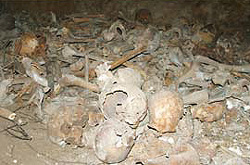Aramean and Armenian mass grave found in the neighborhood of the city of Mardin.
Many villages inhabited by Arameans (including "Assyrians" and Chaldeans) and Armenian population were completely ethnic cleansed by Turks and Kurdish clans. The eyewitness report of Abdel Messih Naman Karabish explains the terrible atrocities committed by the Turks and Kurds in Mardin and environs in detail. See the Aramean Genocide.
Found by Villagers; Covered up by the Military
Source: http://www.armeniandiaspora.com/archive/72213.html
 |
 |
[October 30, 2006] Turkish gendarmerie has instructed local villagers of a southeastern region to keep silence about a recently discovered mass burial site that might contain skeletons of massacred Armenians. The mass burial, believed to be from the Armenian Genocide, was discovered in southeastern Turkey's Mardin region on October 17, 2006. |
According to Ülkede Özgür Gündem , a Kurdish newspaper published in Turkish, villagers from Xirabebaba (Kuru) were digging a grave for one of their relatives when they came across to a cave full of skulls and bones of reportedly 40 people.
The Xirabebaba residents assumed they had uncovered a mass grave of 300 Armenian villagers massacred during the Genocide of 1915. They informed Akarsu Gendarmerie headquarters, the local military unit, about the discovered cave. Turkish army officers, according to Ülkede Özgür Gündem, instructed the villagers to blockade the cave entrance and make no mention about the skeletons. The officers said an investigation would take place.
Ülkede Özgür Gündem reported on the developments and the Turkish military's attempt to hide the news. In an October 22, 2006 article, titled Found by Villagers; Covered up by the Military, the newspaper wrote that soldiers from Akarsu gendarmerie headquarters came to the site, covered the cave entrance and took photographs. Journalists, who had arrived to obtain more information, were denied access to the cave.
Although there had been prior instances of finding mass burial sites believed to be from the Armenian Genocide, this was the first incident when such a discovery was reported by a daily newspaper in Turkey.
As the mass burial made news, local gendarmerie made another visit to the villagers. The latter were pressed to report the name of the person who leaked the mass burial discovery to the press. The officers told the villagers that the news reported by Roj TV, an international Kurdish satellite television, and Ülkede Özgür Gündem were all lies. The villagers were warned not to show the way to the cave to anybody.
The victims of the mass grave, according to Södertörn University History Professor David Gaunt, are most likely the 150 Armenian and 120 Syrian [=Aramean] males, heads of their families, from the nearby town of Dara (now Oguz) killed on June 14, 1915.
The Armenian and Syrian[=Aramean] residents were marched out of the town, and only one person was known to have escaped to tell of what had happened, Prof. Gaunt says. According to the Syrian [=Aramean) survivor, his marching neighbors were murdered and their bodies were placed in a well. The mass burial in this cave suggests that the two groups could have been killed in separate places, and that the Armenians were put into this cave, while the Syrians [=Aramean] were put in a well, Prof. Gaunt, whose Massacres, Resistance, Protectors: Muslim-Christian Relations in Eastern Anatolia during World War I book comes out November, 2006, concludes.
The Turkish government officially denies the genocide of over a million Armenians, accompanied with massacres of thousands of Syrians[=Arameans] and other minorities, which took place in what is now eastern Turkey during WWI.
Photographs by Ülkede Özgür Gündem. Republished by permission.
Ayse Gunaysu, Istanbul
A draft of this report has been initially published at www.blogian.hayastan.com